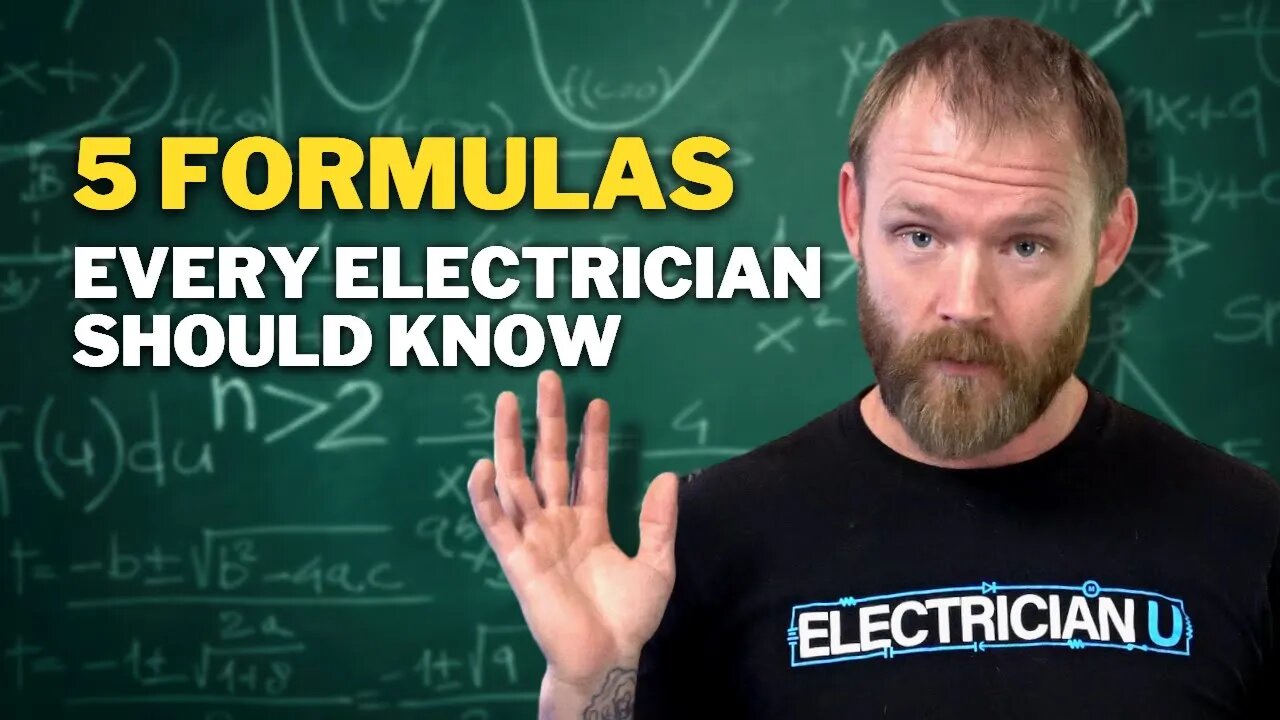Premium Only Content

Are You an Electrician? These are 5 Formulas You Should Know!
Join this channel to get access to perks:
https://www.youtube.com/channel/UCB3jUEyCLRbCw7QED0vnXYg/join
Being a great electrician requires a strong knowledge of math. We use it daily from bending conduit, to figuring out what wire to pull, even simply counting light fixtures or circuits. But which formulas should we be more familiar with? In todays episode of Electrician U, Dustin explains the top 5 formulas every electrician should know.
🤘⚡️MEMBERSHIP⚡️🤘
JOIN ELECTRICIAN U - become a member and get:
FREE Continuing Education every year
FREE Practice Exams
FREE Monthly Video Courses
FREE Weekly Live Instructor-Led Classes
FREE Monthly Educational Newsletter
Premium Members-Only Content
Private Discord Channel
Monthly Members-Only Discord Chats
Sign up here --- https://www.electricianu.com/electrician-u-membership/
🎧🎹MUSIC AND VIDEO:🎹🎧
https://www.facebook.com/descantmv
🎬✍️ART AND ILLUSTRATION:✍️🎬
https://www.daverussoart.com
First on the list is Ohms law. This formula is the relationship between Voltage, Amperage, and Resistance. In many cases, we are not given ALL of the information for a piece of equipment, but still need to determine either the voltage or amperage of it. Ohms law is simply E (voltage) over I (amperage) times R (resistance). So, draw a circle and put a large T in the center of it. Above the horizontal line of the T draw an E. On the left of the vertical line draw an I and on the right of the line draw an R. To assist you, cover up the letter you are attempting to solve. For instance, if I covered up E (voltage) it would leave me with I (amperage) multiplied by R (resistance). If I had a 20a piece of equipment with a 6 ohm resistance (20 x 6) it would be running at 120v!
The next formula is Joules law. This one is slightly different than Ohms law and is the relationship between Wattage, Amperage, and Voltage. The circle is the same as above but with a P on top, an I on the left, and an E on the right. The math is the same also. So, if I was attempting to see how many watts were on a given circuit, cover up the P and I am left with I (amperage) times E (voltage). For a 20a circuit operating at 120v, I would have 2400w. Both of these formulas are very useful because we don’t always get all of the information we need on the equipment nameplate.
Voltage Drop is something that every electrician should know how to figure out. For a single phase circuit the formula is 2 x K(conductor) x I (circuit amperage) x L (length) divided by the circular mils of the conductor you are attempting to use. For 3 phase replace the 2 with a 1.732 (the square root of 3). If you have a copper conductor use 12.9 and use 21.2 if you are using aluminum conductors. The circular mils for electrical conductors can be found in the NEC codebook in Chapter 9 Table 8. The resulting number after crunching the equation is the amount of volts that are lost. You may find that you may need to upsize your wire (and perhaps the conduit) to get your voltage drop down to a reasonable level.
Resistance formulas are needed for every electrical theory class! For a series circuit the total resistance is the sum of all the resistances. For a parallel circuit, it’s the reciprocal of the sum of all the reciprocals. So, 1 divided by 1/R1 + 1/R2 + 1/R3 + etc. An easier way for that last one would be product over sum formula. So, if you had a parallel circuit with resistances of 2, 3, & 4 the formula would be 2 x 3 x 4 divided by 2 + 3 + 4. Much Simpler!
Lastly is Horsepower. Something to just keep in mind is that 1 HP is equivalent to 746 watts. For single phase motors the formula is HP= E (voltage) x I (amperage) x EFF (efficiency) x PF (power factor) divided by 746. For a 3 phase motor, simply insert 1.732 (the square root of 3) in front of the E. Efficiency you can find on the nameplate of the motor. If you have a completely balanced load that isn’t running a ton of motors you may have a power factor of close to 1. The more motors you have on any given system, that number goes down (say to .7 or even more).
We hope this has been helpful in understanding the 5 most popular formulas an electrician uses frequently. Is there a topic you would like to see discussed on Electrician U? Leave us a comment in the comments section and let us know. Please continue to follow Dustin and Electrician U as we are constantly updating our content to assist our followers in becoming the best electricians that they can be.
#electrician #electrical #electricity #these #are #five #formulas #you #should #know
-
 0:57
0:57
Electrician U
1 year agoMy FAVORITE Tester for Electricians - What Hand Tools Are YOU Missing
5.68K -
 LIVE
LIVE
FoeDubb
6 hours ago🏰KINGDOM MENU :🎮LATE NITE PUBG 🤣MOST LIKELY A BAD IDEA DILLY DILLY!!!
26 watching -
 1:34:52
1:34:52
Glenn Greenwald
7 hours agoIs There Evidence of Epstein's Ties to Israel? Yes: Ample. Brazil's Chief Censor Orders Rumble to Ban US Citizen and Turn Over Data | SYSTEM UPDATE #486
129K117 -
 LIVE
LIVE
GamerGril
1 hour agoMarvel Rivals Monday | Battle Of The Bronze
56 watching -
 46:08
46:08
FanatikGaming
1 hour ago💪Monday Motivation🦾 - Legends Never DIE!💯💯 ATWU - BTTB!☝️🔥
2 -
 LIVE
LIVE
WolfLinksShadow
1 hour agoMario Kart Monday & More!
32 watching -
 58:16
58:16
Redacted News
10 hours agoThe Secret Space Program IS REAL and this Whistleblower is EXPOSING all of it
69.1K247 -
 LIVE
LIVE
This is the Ray Gaming
2 hours ago $0.03 earnedHead Shots and Heart Breaks | Rumble Premium Creator
85 watching -
 3:45:47
3:45:47
tangodelta
4 hours agoGray Zone Warfare - Lamang Real Estate
7.82K1 -
 2:08:28
2:08:28
megimu32
3 hours agoOTS: Movies That Scarred Us… and Made Us Scream HELL YEA!
6.7K5